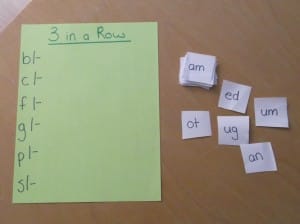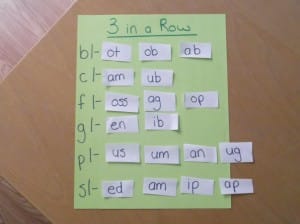Multisensory Monday- Three in a Row
Posted by Brainspring on 7th Sep 2014
Hi everyone,
Welcome to Multisensory Monday! Today I have another idea inspired by a teacher who attended a training over the summer. People have been sharing so many activities and ideas with me this summer that it’s taking me a while to pass them on to you. Keep the ideas coming! You can always email me (sarahz@rlac.com) or comment here with things you think other teachers would like too.
Today’s activity can be used as the multisensory during a Phonics First lesson or it can be used as an additional game or center activity. My example goes with Phonics First Foundations Lesson 2-10 A “l” blends, but feel free to use this with any of the beginning blends lessons or even with CVC words in Layer 1!
Three in a Row
This game can be played individually or with partners. You’ll need a sheet of colored paper to make the board, white paper or index cards to make into small cards, markers and scissors.
 In column on the left edge of the colored paper write the beginning blends (or beginning consonant) sounds you will be using. Cut the paper or index cards into rectangles small enough to fit into the space next to each beginning blend. Make enough cards so that each beginning blend can have three cards after it. My lesson had 6 beginning blends, so I needed 18 cards. Write a word ending on each card, making sure at least 3 endings can go with each beginning blend. The easiest way to do this is to use the dictation words from the lesson you are using.
In column on the left edge of the colored paper write the beginning blends (or beginning consonant) sounds you will be using. Cut the paper or index cards into rectangles small enough to fit into the space next to each beginning blend. Make enough cards so that each beginning blend can have three cards after it. My lesson had 6 beginning blends, so I needed 18 cards. Write a word ending on each card, making sure at least 3 endings can go with each beginning blend. The easiest way to do this is to use the dictation words from the lesson you are using.
 To play, turn the cards face down next to the board. Cards are drawn one card at a time and placed next to a beginning blend that can be added to make a real word. Partners simply take turns drawing and placing the cards.
To play, turn the cards face down next to the board. Cards are drawn one card at a time and placed next to a beginning blend that can be added to make a real word. Partners simply take turns drawing and placing the cards.
At first, let the students place the cards next to any beginning that makes a real word. The game is not over, however, until each beginning has 3 cards next to it. This means once all the cards are drawn and placed, they may need to be moved around so that each blend is used to make 3 real words. This final step can be challenging, which is great because it encourages students to use problem-solving skills and furthers their interaction with the sounds and spellings from the lesson!


